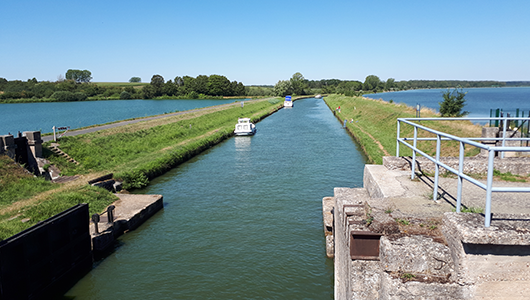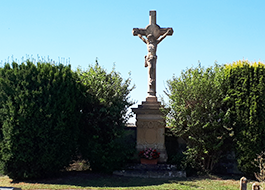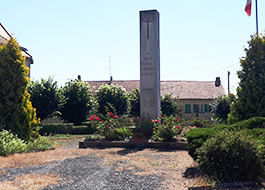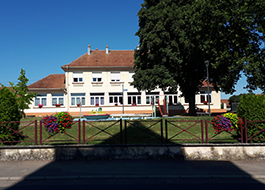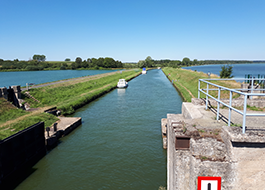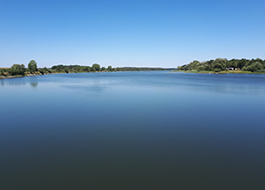Gondrexange
Durée visite : 80 minutes
Moyen : Pédestre
Le village appartenait à l’évêché de Metz, dans le comté de Réchicourt. Dés 1373, un étang est aménagé. Gondrexange est rebâti après 1945. C’est le village natal de Jean-Baptiste Michel, général de la Révolution française. En 1796, il participe à l’expédition de Saint-Domingue, contre la révolte des esclaves menée par Toussaint L’Ouverture. C’est un échec. On perd sa trace après 1803.
The village belonged to the bishopric of Metz, in the county of Réchicourt. From 1373, a pond was built. Gondrexange was rebuilt after 1945. It is the birthplace of Jean-Baptiste Michel, general of the French Revolution. In 1796, he took part in the Saint-Domingue expedition, against the slave revolt led by Toussaint L’Ouverture. It’s a fail. We lose track of it after 1803.
Das Dorf gehörte dem Bistum Metz in der Grafschaft Réchicourt. Ab 1373 wurde ein Teich gebaut. Gondrexange wurde nach 1945 wieder aufgebaut. Es ist der Geburtsort von Jean-Baptiste Michel, General der Französischen Revolution. 1796 nahm er an der Saint-Domingue-Expedition gegen den von Toussaint L’Ouverture angeführten Sklavenaufstand teil. Es ist ein Fehlschlag. Wir verlieren es nach 1803 aus den Augen.

D’azur à deux bars d’or adossés issant de la pointe, surmontés de trois aiglettes d’argent disposées 2-1.
Les aiglettes sont les armes des comtes de Linange, seigneurs du lieu. Les bars sont ceux des comtes de Réchicourt d’où relevait la seigneurie, mais ici, ils sont sur un fond d’azur pour rappeler l’étang de Gondrexange.
Azure with two back-to-back bars Or issuing from the point, surmounted by three silver eaglets arranged 2-1.
The eaglets are the arms of the counts of Linange, lords of the place. The bars are those of the counts of Réchicourt from which the seigneury was located, but here, they are on an azure background to recall the pond of Gondrexange.
Azurblau mit zwei hintereinander angeordneten Balken Oder Ausgehend von der Spitze, überragt von drei Silberadlern, die mit 2: 1 angeordnet sind.
Die Adler sind die Arme der Grafen von Linange, den Herren des Ortes. Die Balken sind die der Grafen von Réchicourt, von denen aus sich das Seigneury befand, aber hier befinden sie sich auf einem azurblauen Hintergrund, um an den Teich von Gondrexange zu erinnern.

Les habitants de Gondrexange s’appellent les Gondrexangeois et les Gondrexangeoises.
The inhabitants of Gondrexange are called Gondrexangeois and Gondrexangeoises.
Die Einwohner von Gondrexange heißen Gondrexangeois und Gondrexangeoises.
Les points de visites
Le cimetière a été installé à l’extérieur du village, au 19e siècle, conformément aux nouvelles normes hygiénistes. Il remplace l’ancien cimetière situé autour de l’église paroissiale. La tombe la plus ancienne porte la date de 1900. Le décor de nombreuses tombes est remarquablement riche et soigné. Il emprunte les modèles architecturaux imitant la nature. Son répertoire stylistique peut aussi être purement ornemental. Il relève souvent de l’iconographie funéraire. Ce sont principalement des artistes locaux ou régionaux qui ont œuvré ici.
The cemetery was installed outside the village in the 19th century, in accordance with new hygienic standards. It replaces the old cemetery located around the parish church. The oldest tomb dates from 1900. The decor of many tombs is remarkably rich and neat. It borrows architectural models imitating nature. Its stylistic repertoire can also be purely ornamental. It often relates to funerary iconography. It is mainly local or regional artists who have worked here.
Der Friedhof wurde im 19. Jahrhundert außerhalb des Dorfes nach neuen Hygienestandards errichtet. Es ersetzt den alten Friedhof rund um die Pfarrkirche. Das älteste Grab stammt aus dem Jahr 1900. Das Dekor vieler Gräber ist bemerkenswert reich und ordentlich. Es leiht Architekturmodelle aus, die die Natur imitieren. Das stilistische Repertoire kann auch rein dekorativ sein. Es bezieht sich oft auf die Begräbnisikonographie. Es sind hauptsächlich lokale oder regionale Künstler, die hier gearbeitet haben.
.
.
La ligne de Paris à Strasbourg est inaugurée le 17 juillet 1852. Il n’y a pas alors de station à Gondrexange. Celle-ci est mise en service par la Direction générale impériale des chemins de fer d’Alsace-Lorraine, en 1907. Elle dispose d’un petit bâtiment voyageurs, établi à gauche de la voie. Détruit lors de la seconde guerre mondiale, il est reconstruit en 1964. Une halle aux marchandises en bois avait aussi été édifiée par les allemands. La gare est aujourd’hui fermée à tout trafic.
The line from Paris to Strasbourg was inaugurated on July 17, 1852. At that time, there was no station at Gondrexange. This was put into service by the Imperial General Directorate of Railways in Alsace-Lorraine in 1907. It has a small passenger building, established to the left of the track. Destroyed during the Second World War, it was rebuilt in 1964. A wooden goods hall had also been built by the Germans. The station is now closed to all traffic.
Die Linie von Paris nach Straßburg wurde am 17. Juli 1852 eingeweiht. Zu dieser Zeit gab es in Gondrexange keine Station. Diese wurde 1907 von der kaiserlichen Generaldirektion Eisenbahnen in Elsass-Lothringen in Betrieb genommen. Links vom Gleis befindet sich ein kleines Fahrgastgebäude. Während des Zweiten Weltkriegs zerstört, wurde es 1964 wieder aufgebaut. Auch die Deutschen hatten eine Holzwarenhalle gebaut. Der Bahnhof ist jetzt für den gesamten Verkehr gesperrt.
.
.
L’inscription est abîmée. Mais on peut déchiffrer qu’il s’agit d’un ex-voto, datant des années 1880. Un ex-voto est une offrande faite à Dieu, en demande ou en remerciement d’une grâce, obtenue à l’issue d’un vœu formulé en ce sens.
The inscription is damaged. But we can decipher that it is an ex-voto, dating from the 1880s. An ex-voto is an offering made to God, in request or in gratitude for a grace, obtained at the end of a vow formulated in this sense.
Die Inschrift ist beschädigt. Aber wir können entziffern, dass es sich um ein Ex-Voto aus den 1880er Jahren handelt. Ein Ex-Voto ist ein Opfer, das Gott auf Bitte oder aus Dankbarkeit für eine Gnade dargebracht wird und das am Ende eines in diesem Sinne formulierten Gelübdes erlangt wird.
.
.
Détruite par un incendie en 1840, elle est reconstruite peu après. L’architecte Dumont de Sarrebourg en fixe les plans . Elle reçoit un beffroi avec 3 cloches.Le portail est néo-classique. Le chœur abrite des boiseries et des stalles en bois sculptées. Elles datent de la fin du 18e siècle. Un pavement en céramique, signé Villeroy et Boch, est mis en place en 1884. Les verrières de l’église proviennent de trois ateliers de peintres-verriers. Deux du chœur sortent des ateliers artistiques de Munich, les deux autres des ateliers OTT frères. Dans la nef, les vitraux provenant des ateliers Ott Frères de Strasbourg sont datés de 1949. Ceux des ateliers Gross et Georges Bassinot de Nancy sont de 1956. Ces derniers représentent le martyr des deux religieuses de Saint-Vincent de Paul, Marie-Anne et Odile. Elles furent fusillées à Angers pendant la Révolution. Sœur Odile Baumgarten est née en 1750 à Gondrexange. Très rare, cette iconographie n’est guère présente qu’à Gondrexange. On la retrouve seulement dans la chapelle élevée sur leur lieu d’exécution.
Destroyed by fire in 1840, it was rebuilt shortly after. The architect Dumont de Sarrebourg fixed the plans. It receives a belfry with 3 bells. The portal is neo-classical. The choir houses woodwork and carved wooden stalls. They date from the end of the 18th century. A ceramic pavement, signed Villeroy and Boch, was put in place in 1884. The windows of the church come from three workshops of glass painters. Two of the choir come from artistic workshops in Munich, the other two from brother OTT workshops. In the nave, the stained glass windows from the Ott Frères workshops in Strasbourg date from 1949. Those from the Gross and Georges Bassinot workshops in Nancy are from 1956. These represent the martyr of the two nuns of Saint-Vincent de Paul, Marie-Anne and Odile. They were shot in Angers during the Revolution. Sister Odile Baumgarten was born in 1750 in Gondrexange. Very rare, this iconography is hardly present except in Gondrexange. It is only found in the chapel erected at their place of execution.
1840 durch einen Brand zerstört, wurde es kurz darauf wieder aufgebaut. Der Architekt Dumont de Sarrebourg legte die Pläne fest. Es erhält einen Glockenturm mit 3 Glocken. Das Portal ist neoklassisch. Der Chor beherbergt Holzarbeiten und geschnitzte Holzstände. Sie stammen aus dem Ende des 18. Jahrhunderts. Ein Keramikpflaster, signiert mit Villeroy und Boch, wurde 1884 errichtet. Die Fenster der Kirche stammen aus drei Werkstätten von Glasmalern. Zwei der Chöre stammen aus künstlerischen Werkstätten in München, die anderen zwei aus Bruder-OTT-Werkstätten. Im Kirchenschiff stammen die Buntglasfenster aus den Werkstätten von Ott Frères in Straßburg aus dem Jahr 1949. Die aus den Werkstätten von Gross und Georges Bassinot in Nancy stammen aus dem Jahr 1956. Sie repräsentieren den Märtyrer der beiden Nonnen von Saint-Vincent de Paul, Marie- Anne und Odile. Sie wurden während der Revolution in Angers erschossen. Schwester Odile Baumgarten wurde 1750 in Gondrexange geboren. Sehr selten ist diese Ikonographie außer in Gondrexange kaum vorhanden. Es befindet sich nur in der Kapelle, die an ihrem Hinrichtungsort errichtet wurde.
.
.
Un obélisque est dressé prés de l’église. Il est dédié aux morts des deux guerres mondiales. La complexité de l’histoire mosellane est marquée par un manque. La mention Mort pour la France ne figure pas. Certains enfants de la commune sont des Malgré-Nous. Une liste des morts de 14-18 est apposée sur le mur d’entrée de Saint-Luc. Une stèle rappelle le souvenir de sœur Odile. Martyre de la Terreur en 1794, elle fut faite bienheureuse deux siècles après.
An obelisk is erected near the church. It is dedicated to the dead of the two world wars. The complexity of Moselle history is marked by a lack. The mention Death for France does not appear. Some children of the town are Despite-Us. A list of the 14-18 dead is affixed to the entrance wall of Saint-Luc. A stele recalls the memory of Sister Odile. Martyrdom of Terror in 1794, she was made blessed two centuries later.
In der Nähe der Kirche wird ein Obelisk errichtet. Es ist den Toten der beiden Weltkriege gewidmet. Die Komplexität der Moselgeschichte ist durch einen Mangel gekennzeichnet. Die Erwähnung Tod für Frankreich erscheint nicht. Einige Kinder der Stadt sind Trotz uns. Eine Liste der 14-18 Toten ist an der Eingangswand von Saint-Luc angebracht. Eine Stele erinnert an Schwester Odile. Das Martyrium des Terrors wurde 1794 zwei Jahrhunderte später gesegnet.
.
.
L’école primaire date de 1970. Elle accueille 50 enfants. Elle regroupe maternelle et cours élémentaire. En France, l’instruction est obligatoire, depuis septembre 2019, pour les enfants de 3 à 16 ans. La population de Gondrexange compte 491 habitants.
The primary school dates from 1970. It accommodates 50 children. It combines kindergarten and elementary lessons. In France, education has been compulsory since September 2019 for children aged 3 to 16. The population of Gondrexange counts 491 inhabitants.
Die Grundschule stammt aus dem Jahr 1970. Sie bietet Platz für 50 Kinder. Es kombiniert Kindergarten- und Grundschulunterricht. In Frankreich ist die Schulbildung für Kinder im Alter von 3 bis 16 Jahren seit September 2019 obligatorisch. Die Bevölkerung von Gondrexange zählt 491 Einwohner.
.
.
Deux canaux passent sur le ban communal. Le canal des houillères de la Sarre, a été creusé entre 1861 et 1866, au gabarit Freycinet (250 tonnes) Il raccorde le bassin houiller de la Sarre aux industries d’Alsace. Il relie la Sarre depuis Sarreguemines au canal de la Marne au Rhin, à Gondrexange. En 1980, la Sarre a été mise au grand gabarit rhénan (1500 à 3000 tonnes) Cela permet de rejoindre de Rhin par la Moselle. Le canal de la Marne au Rhin est long de 314 km. Il comptait 178 écluses à l’origine. Il relie la Marne (à Vitry-le-François) au Rhin (à Strasbourg). Par le canal latéral de la Marne, il est connecté au réseau navigable de la Seine vers l’Île-de-France et la Normandie. Il date des années 1838 à 1853.
Two canals pass on the communal ban. The coal mine canal of the Sarre, was dug between 1861 and 1866, to the Freycinet gauge (250 tons.) It connects the coal basin of the Sarre to the industries of Alsace. It links the Saar from Sarreguemines to the Marne-Rhine canal at Gondrexange. In 1980, the Saar was upgraded to the large Rhine gauge (1,500 to 3,000 tonnes) This makes it possible to reach from the Rhine via the Moselle. The Marne-Rhine canal is 314 km long. It originally had 178 locks. It connects the Marne (in Vitry-le-François) to the Rhine (in Strasbourg). By the lateral canal of the Marne, it is connected to the navigable network of the Seine towards the Île-de-France and Normandy. It dates from the years 1838 to 1853.
Zwei Kanäle geben das Gemeinschaftsverbot weiter. Der zwischen 1861 und 1866 gegrabene Kohlengrubenkanal der Sarre wurde bis zur Freycinet-Spurweite (250 Tonnen) gegraben. Er verbindet das Kohlebecken der Sarre mit den Industrien des Elsass. Es verbindet die Saar von Sarreguemines mit dem Marne-Rhein-Kanal in Gondrexange. 1980 wurde die Saar auf die große Rheinspur (1.500 bis 3.000 Tonnen) umgerüstet, so dass vom Rhein über die Mosel erreicht werden kann. Der Marne-Rhein-Kanal ist 314 km lang. Es hatte ursprünglich 178 Schlösser. Es verbindet die Marne (in Vitry-le-François) mit dem Rhein (in Straßburg). Durch den Seitenkanal der Marne ist es mit dem schiffbaren Netz der Seine in Richtung Île-de-France und Normandie verbunden. Es stammt aus den Jahren 1838 bis 1853.
.
.
Créé au Moyen Âge par les moines pisciculteurs, l’étang de Gondrexange s’étend sur 700 hectares C’est un haut lieu de pêche réputé pour sa richesse en sandre, brochet, perche. La commune fait partie du parc naturel régional de Lorraine. Elle relève aussi de Zone naturelle d’intérêt écologique, faunistique et floristique du pays des étangs. Celui-ci est une région naturelle lorraine. Il est constitué de plus d’une centaine d’étangs naturels ou artificiels créés au Moyen Âge, principalement pour la pisciculture. Une agréable base de loisirs est implantée en ce lieu.
Created in the Middle Ages by fish-farming monks, the pond of Gondrexange covers 700 hectares. It is a major fishing spot renowned for its richness in pike-perch, pike, perch. The town is part of the Lorraine regional natural park. It also falls under the Natural Area of Ecological, Faunistic and Floristic Interest of the Land of Ponds. This is a natural region of Lorraine. It consists of more than a hundred natural or artificial ponds created in the Middle Ages, mainly for fish farming. A pleasant leisure center is located here.
Der Teich von Gondrexange wurde im Mittelalter von Mönchen aus der Fischzucht angelegt und erstreckt sich über 700 Hektar. Er ist ein wichtiger Angelplatz, der für seinen Reichtum an Hecht, Hecht und Barsch bekannt ist. Die Stadt ist Teil des regionalen Naturparks Lothringen. Es fällt auch unter das Naturgebiet von ökologischem, faunistischem und floristischem Interesse des Landes der Teiche. Dies ist eine natürliche Region Lothringens. Es besteht aus mehr als hundert natürlichen oder künstlichen Teichen, die im Mittelalter hauptsächlich für die Fischzucht angelegt wurden. Hier befindet sich ein angenehmes Freizeitzentrum.
.

